Spider Collector's Journal (32nd page: 2022) Copyright © 2022 by Rod Crawford
Here's the 32nd page of narratives of fun (and not so fun) trips to collect spiders for research at the Burke Museum, some accompanied by capable field volunteers: Laurel Ramseyer and new recruits. Most also appeared in Scarabogram, newsletter of "Scarabs: The Bug Society." Dates of field trips head each paragraph. Maps showing the location of sites within Washington state follow the grid system outlined in the Washington Spider Checklist. RETURN TO INDEX
Where you see this button ![]() in a
field trip account, click it to get a page of collecting site photos!
in a
field trip account, click it to get a page of collecting site photos!
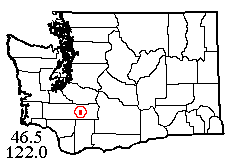 |
![]() 12 II 2022: Thanks to a good forecast for Lewis County, Laurel and I re-instituted our traditional February field trip, heading for the spot predicted to be warmest, Rainey Valley Cemetery along Highway 12 in the eastern third of the county. Reaching the place in due course, we found that a grassy field was matted too low for much sweeping and the rest of the non-lawn habitat was swallowed up by blackberry, including all accessible parts of Stillner Creek. It was too early for any mature wolf spiders, but I did manage to sweep 4 species of grass-dwellers. Thanks to one accessible Douglas-fir tree, Laurel got 3 good species from cones and I added 4 from the foliage. Two more were on a service building, and a windbreak of tall cedar shrubs was loaded with Philodromus dispar. Some dry moss at the base of the cedars had two of the commoner moss-dwellers. The most interesting habitat was a feature of the gravestones: built-in metal vases, stored inverted and recessed into the ground when not in use. These pocket-sized subterranean habitats added 4 species, including several "Lepthyphantes (Palliduphantes)" sp. #8, an uncommon species that's been found underground before. Twenty in all from the cemetery, where we didn't see a living soul the whole time.
12 II 2022: Thanks to a good forecast for Lewis County, Laurel and I re-instituted our traditional February field trip, heading for the spot predicted to be warmest, Rainey Valley Cemetery along Highway 12 in the eastern third of the county. Reaching the place in due course, we found that a grassy field was matted too low for much sweeping and the rest of the non-lawn habitat was swallowed up by blackberry, including all accessible parts of Stillner Creek. It was too early for any mature wolf spiders, but I did manage to sweep 4 species of grass-dwellers. Thanks to one accessible Douglas-fir tree, Laurel got 3 good species from cones and I added 4 from the foliage. Two more were on a service building, and a windbreak of tall cedar shrubs was loaded with Philodromus dispar. Some dry moss at the base of the cedars had two of the commoner moss-dwellers. The most interesting habitat was a feature of the gravestones: built-in metal vases, stored inverted and recessed into the ground when not in use. These pocket-sized subterranean habitats added 4 species, including several "Lepthyphantes (Palliduphantes)" sp. #8, an uncommon species that's been found underground before. Twenty in all from the cemetery, where we didn't see a living soul the whole time.
We hoped for better things on Bowen Road along Kiona Creek, about 1.5 miles east of the cemetery. Certainly the habitats were far more natural, with no visible blackberry. We began by sifting, Laurel getting 13 species from moss on cottonwoods, while I added only 4 from leaf litter that was either far lower-quality than it looked, or not quite warm enough. However, the litter did produce the only adult Ozyptila crab spider for Laurel's project. Understory added 7 for a total of 38, not so bad for winter. I persuaded Laurel to try rearing a gravel-bar wolf spider she found on the bridge. We dined at Spiffy's drive-in in Morton, which we'd rate well below Betty's Place or Mountain High Hamburgers, but OK in its way and with good shakes.
 |
![]() 25 III 2022: A repeat of last month's colder in the north, warmer in the south pattern brought us back to Lewis County, this time to Carlisle Lake Park just outside Onalaska. Carlisle Lake is a former millpond that once served a timber mill of which nothing remains but a tall historic smokestack. A gravelled dogwalking trail circles the lake with various dirt tracks including one more directly along the shore, through young but well-developed cottonwood-dominated forest with varied other trees, grassy openings, and (alas) a wide-spread infiltration of lurking blackberry. To begin with, I headed straight for an area on the far side with visible conifer foliage, staying there the whole day. A bit of grass-sweeping got me 5 species including Spirembolus abnormis; later I added 2 more plus a rearable Pardosa in a bigger somewhat-squashy expanse of field. My first sifting session got me very little from third-rate litter, but later I found some decent stuff under one of the biggest cottonwoods for 6 species plus other goodies. A couple of white pines had dropped enough cones so I could tap 25, but with my usual luck, added no spiders. Finally coming to the accessible conifer foliage, beating that was successful enough, and fern-understory beating added a few more for a total of 25.
25 III 2022: A repeat of last month's colder in the north, warmer in the south pattern brought us back to Lewis County, this time to Carlisle Lake Park just outside Onalaska. Carlisle Lake is a former millpond that once served a timber mill of which nothing remains but a tall historic smokestack. A gravelled dogwalking trail circles the lake with various dirt tracks including one more directly along the shore, through young but well-developed cottonwood-dominated forest with varied other trees, grassy openings, and (alas) a wide-spread infiltration of lurking blackberry. To begin with, I headed straight for an area on the far side with visible conifer foliage, staying there the whole day. A bit of grass-sweeping got me 5 species including Spirembolus abnormis; later I added 2 more plus a rearable Pardosa in a bigger somewhat-squashy expanse of field. My first sifting session got me very little from third-rate litter, but later I found some decent stuff under one of the biggest cottonwoods for 6 species plus other goodies. A couple of white pines had dropped enough cones so I could tap 25, but with my usual luck, added no spiders. Finally coming to the accessible conifer foliage, beating that was successful enough, and fern-understory beating added a few more for a total of 25.
Meanwhile, Laurel seemed to want to add as many subsites around the lake as possible. She sifted alder-trunk moss at the SW corner, adding 8 species including her favorite Ozyptila pacifica; dead wood nearby added 3 more plus a nice ethopolid centipede. At the far NE corner she found some more pines, where cones added introduced Zodarion. Thistle heads on the east side had the only mature Larinioides patagiatus plus a Misumena. Manmade substrates around the parking lot added 3 house spider species; and a grass sweep all the way around the perimeter (requiring coordinates reduced to 0.01 degree accuracy) added three linyphiids, one of which I haven't yet figured out, perhaps an Aphileta. Laurel got plenty of questions on the dog-walking route, while I only talked with one party on my side track. The day finally got sunny and warmer after 3 pm. Spring budding was noticeable here and there, and grass was up enough to sweep, but the cottonwoods were still bare. In all, we got 45 species, and 2 taken nearby long ago make it 47.
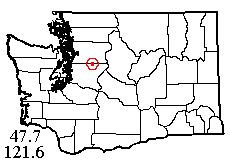 |
![]() 7 IV 2022: For years, Laurel and I have wanted to collect in the area bordering the Tolt River Watershed on the north, but the road into the area has been closed, with entry by permit only. This spring I checked again, just in case, and the Forest Service said it was open! So we waited for a prediction of warm-enough weather, and today was the day! The road was indeed open and after only one wrong turn, there we were a few hundred feet from Cavanaugh Lake. There was unlimited conifer foliage to beat where we parked; up the road was a quarry and a narrow stand of mature hemlock; and the lake itself was as gorgeous as many lakes you have to hike miles to reach!
7 IV 2022: For years, Laurel and I have wanted to collect in the area bordering the Tolt River Watershed on the north, but the road into the area has been closed, with entry by permit only. This spring I checked again, just in case, and the Forest Service said it was open! So we waited for a prediction of warm-enough weather, and today was the day! The road was indeed open and after only one wrong turn, there we were a few hundred feet from Cavanaugh Lake. There was unlimited conifer foliage to beat where we parked; up the road was a quarry and a narrow stand of mature hemlock; and the lake itself was as gorgeous as many lakes you have to hike miles to reach!
The conifer foliage fully realized its promise with 12 spider species, including two Ceraticelus, one unfamiliar. Meanwhile, Laurel was sifting 15 from moss by the lake, including her favorite Ozyptila pacifica. Up at the quarry, our luck wasn't so good: the litter of 2 alder groves added nothing. Laurel added 2 on boulders, one under herb leaves, and our one mature wolf spider, Pardosa wyuta, under charred firewood. My fern-beating added one, and bark-tapping got me an unusual male linyphiid resembling the one Laurel swept on our previous trip. Still, we were up to 29 species now.
Back down near the lakeshore, litter sifting was much better, but only 3 species added to the list. Laurel added 3 more from understory, and we had 35 species from Cavanaugh Lake, where we spent the day in amazing solitude. Except for half an hour when someone was shooting up at the quarry, not one sound of other humans on this balmy day. The whole time, only one plane flew by overhead! On our way out, we stopped at a bridge over Proctor Creek; unfortunately, there was no bridge-railing habitat and the gravel bars produced no wolf spiders, but some more moss sifting added 3 more species (some of the "usual suspects" of lowland moss, missing at the lake). Thanks to the early season, all the mountains were snowy, making this one of the most scenic field trips ever!
 |
![]() 24 IV 2022: A wet, wintry month had us thirsting for drier climes, so we undertook the long drive to Grant County in central Washington. Our main goal was Sunland Park on Wanapum Reservoir (formerly the Columbia River), associated with the Sunland housing development, a dense community of ticky-tacky houses plunked out in the middle of nowhere. Obviously marketed as the land of sun, while carefully failing to mention the wind! Our first stop was a sagebrush/rimrock habitat just above the houses. It looked good, but we got only 3 species from sagebrush, with one each added by herb-sweeping and rock-and-wood turning. So, down to the park!
24 IV 2022: A wet, wintry month had us thirsting for drier climes, so we undertook the long drive to Grant County in central Washington. Our main goal was Sunland Park on Wanapum Reservoir (formerly the Columbia River), associated with the Sunland housing development, a dense community of ticky-tacky houses plunked out in the middle of nowhere. Obviously marketed as the land of sun, while carefully failing to mention the wind! Our first stop was a sagebrush/rimrock habitat just above the houses. It looked good, but we got only 3 species from sagebrush, with one each added by herb-sweeping and rock-and-wood turning. So, down to the park!
In the park's central area of lawns, there were 2 non-native pine trees, so of course Laurel tapped cones. This produced only 2 identifiable species, but one was a new state record, an undetermined Grammonota species, so who's complaining? The outsides of park buildings gave her a mystery dictynid and a nice male of recently introduced salticid Attulus ammophilus. In the less-groomed (I won't say natural) habitat north of the lake, with scattered non-native elms in grass and rabbitbrush, I sifted litter adding 2 species, swept two more, got an unusually long-lived hobo spider under a log and a native Salticus peckhamae from the shrubs; and missed the day's one adult wolf spider among shore boulders. South of the lawn, in similar habitat, Laurel added 4 more (and an adult of one of her young pine cone spiders), making 20 species so far.
But the two sites we visited after leaving the Sunland community had the best habitats of the day. At the state/county, open-to-the-public Sunland Boat Launch, there was true sagebrush habitat with little invasive rabbitbrush. Manmade habitats were no slouch there either: the chain-link fence added two or three more Dictyna species, the outhouse a mystery Philodromus plus the first Washington record of introduced pholcid Holocnemus pluchei! Then, as the sun sank, we visited a Department of Wildlife site high above the river. This lovely area had not only more natural sagebrush, but natural bunchgrass and flowers in between! The foliage here added 4 more species (including a male black widow on the sagebrush), making 28-30 for the day.
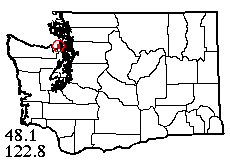 |
![]() 1 V 2022: This time, we made it a ferry trip to minimize driving time. The goal was a section of the Quimper Peninsula to the west of Port Townsend, where housing development is eating up chunks of the landscape but enough public land parcels still exist to provide spider habitat. Our first stop was an unnamed tract of woods (cedar and alder, mostly) belonging to the city of Port Townsend. I found alder litter that was more spider-rich than any I'd seen this year, and kept sifting until I had 14 species. Laurel had similar luck with moss (19 species total), but no Ozyptila whatever, in fact not one crab spider! We got 10 species in fern understory (only one in salal that was different, though) and Laurel got a solitary Metellina curtisi in her web. Total so far, 31, in the year-so-far's champ site for sheer numbers of spiders.
1 V 2022: This time, we made it a ferry trip to minimize driving time. The goal was a section of the Quimper Peninsula to the west of Port Townsend, where housing development is eating up chunks of the landscape but enough public land parcels still exist to provide spider habitat. Our first stop was an unnamed tract of woods (cedar and alder, mostly) belonging to the city of Port Townsend. I found alder litter that was more spider-rich than any I'd seen this year, and kept sifting until I had 14 species. Laurel had similar luck with moss (19 species total), but no Ozyptila whatever, in fact not one crab spider! We got 10 species in fern understory (only one in salal that was different, though) and Laurel got a solitary Metellina curtisi in her web. Total so far, 31, in the year-so-far's champ site for sheer numbers of spiders.
A second pre-selected site turned out to have no accessible conifer foliage, so we rolled on to a tract of DNR land on Jacob Miller Road, and found it's been transformed (via a 50-year lease) into the Quimper West Preserve: an 80-acre patchwork of swampy and upland forest, no very big trees but an unusual mix of species, very dense, and bisected by a somewhat muddy trail much in use by neighborhood walkers and runners. Intermittent grand-fir foliage along the main trail gave me 12 species, including an unfamiliar Pityohyphantes plus Linyphantes orcinus. Laurel swept trailside grass and got Linyphantes nehalem instead, plus other things. One net-full of trailside moss added two more species, and the flowers of a bitter-cherry tree a passerby pointed out to us, had the day's only Misumena vatia. Up to 42 species now.
Now we moved to the adjacent roadside, where we finally found some Douglas-fir. I beat branches of one, and Laurel found another that had dropped 90 open cones for her to tap! Here, I got a rare Theridion, yet another Pityohyphantes species, a mature Ero canionis pirate spider, and finally a couple of Philodromus species. Laurel's cones confirmed one of the Philodromus and added introduced Zodarion. Total species, 46.
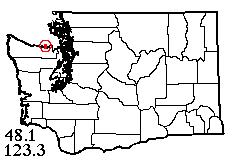 |
![]() 21 V 2022: It wasn't a holiday weekend, just a sunny Saturday, so we figured being an hour early for the ferry would be a safe margin. Wrong! We had to wait for the next ferry after, and arrived at the outskirts of Port Angeles well into the afternoon. But we found the Strait View trailhead for the Olympic Discovery Trail (a rail trail) without trouble, proceeded just a short distance (crossing Morse Creek on a renovated trestle), and found a dirt side trail down to the creekside and the lushest imaginable green, green riparian forest. Seemingly unaffected by the invasive-earthworm plague that has decimated leaf litter at many sites, litter here was thick and juicy; 4 bags (from cottonwood and maple) produced 10 spider species plus other stuff. Laurel added 5 more sifting moss on tree trunks — but no Ozyptila. Understory ferns added three.
21 V 2022: It wasn't a holiday weekend, just a sunny Saturday, so we figured being an hour early for the ferry would be a safe margin. Wrong! We had to wait for the next ferry after, and arrived at the outskirts of Port Angeles well into the afternoon. But we found the Strait View trailhead for the Olympic Discovery Trail (a rail trail) without trouble, proceeded just a short distance (crossing Morse Creek on a renovated trestle), and found a dirt side trail down to the creekside and the lushest imaginable green, green riparian forest. Seemingly unaffected by the invasive-earthworm plague that has decimated leaf litter at many sites, litter here was thick and juicy; 4 bags (from cottonwood and maple) produced 10 spider species plus other stuff. Laurel added 5 more sifting moss on tree trunks — but no Ozyptila. Understory ferns added three.
Now we hiked a half mile down the main trail to the beach, a nice one on the shore of the Strait with not a soul on it. I tried sifting wrack with no result, but Laurel found one active spider on a log; uncommon Spirembolus latebricola! Beach meadow was rich and varied here, and sweeping produced 5 species, one of them also beaten from a feral apple tree. Now, we were up to 24 species.
Back at the trailhead, I tried beating conifer foliage: it was rich, with 13 species. Sweeping the grassy fields around the parking lot added nothing, but Laurel found a population of the rare tube-weaver Segestria pacifica (plus one of the common house spiders) in the chinks of an unoccupied log cabin. Total for Morse Creek, 36 species in a short day (making 38 with old records). But our adventures weren't over! The burger place at Discovery Bay was still closing early, and before the Hood Canal Bridge was a flashing sign "2 hour wait for ferry". By that time, it was only 2 hours until the very last ferry! Fortunately, we were able to get home in only 90 minutes (from the bridge) by way of the Tacoma Narrows.
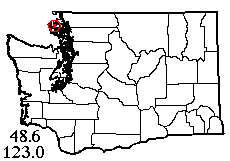 |
![]() 24 V 2022: Laurel wanted to check for Ozyptila crab spiders at Friday Harbor. A ferry trip to San Juan Island is a big production, so she thought it best to drag me along so I could get a new spider sample from one of the 2 remaining unsampled corners of the island. I had her drop me off at Reuben Tarte County Park, on the island's northeast coast, while she returned to town to tap hundreds of pine cones (finding no crab spiders). I had arranged for longtime correspondent Cyndi Brast, who lives on the island, to join me at the park, and she showed up a few minutes after Laurel left. We collected initially in the scenic beach and headland area. Sweeping grass here was not very productive, but gave me a start of three common species. The sea-stunted Douglas-firs on the headland had very dense and lush foliage, but only added three more spider species (plus various insects for Cyndi's camera). Under driftwood on the upper beach, we found an unusually large, probably undescribed native Protolophus harvestman, and two non-native spider species, Lepthyphantes tenuis and Dysdera crocata. Total spider species from the beach, 8.
24 V 2022: Laurel wanted to check for Ozyptila crab spiders at Friday Harbor. A ferry trip to San Juan Island is a big production, so she thought it best to drag me along so I could get a new spider sample from one of the 2 remaining unsampled corners of the island. I had her drop me off at Reuben Tarte County Park, on the island's northeast coast, while she returned to town to tap hundreds of pine cones (finding no crab spiders). I had arranged for longtime correspondent Cyndi Brast, who lives on the island, to join me at the park, and she showed up a few minutes after Laurel left. We collected initially in the scenic beach and headland area. Sweeping grass here was not very productive, but gave me a start of three common species. The sea-stunted Douglas-firs on the headland had very dense and lush foliage, but only added three more spider species (plus various insects for Cyndi's camera). Under driftwood on the upper beach, we found an unusually large, probably undescribed native Protolophus harvestman, and two non-native spider species, Lepthyphantes tenuis and Dysdera crocata. Total spider species from the beach, 8.
By the time Cyndi had to leave, we'd had several sprinkles of drizzle, and it looked as if it might really rain; but I assured her I'd be OK, so she left me alone to collect in upland habitats. Fortunately, although the drizzle continued, it never became serious rain at the park, and never penetrated the closed tree canopy. So, time for litter sifting! What litter?? There were some alder trees and a couple of madronas along the park road, but their litter was long gone, victim of the invasive worms that must be long-established in the islands. I had to settle for conifer litter with a few salal leaves; spiders were sparse, but it did add 4 species including an uncommon Agyneta. Some of the trees had moss, but mostly too thin to sift; I managed to get one sifter-load from about 7 trees, adding only the ubiquitous Ethobuella. But the site's spider bonanza lay ahead of me: salal understory! Beating salal under the tree-canopy umbrella eventually got me 11 species, and I was just finishing this when Laurel arrived about an hour before time to return to the ferry dock. She added a native Philodromus from Douglas-fir cones and Pelecopsis from her fallen-moss-clod habitat; meanwhile, I added 4 more species from somewhat-wet conifers around the parking lot, and a very unusual Bathyphantes from very wet grass. In the end, I had a decent 28-species sample from the park, making 29 with one prior record.
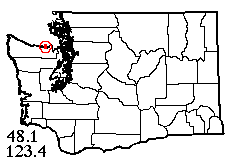 |
![]() 31 V 2022: Another check for Ozyptila crab spiders was in order, this time in the Clallam County coastal city of Port Angeles. As it happened, I had no spider records at all from the city, though some nearby areas were well-sampled. So while Laurel looked at mid-urban pine cones, she dropped me off at the north trailhead for Verne Samuelson Trail, in a county property along Valley Creek. The valley of Valley Creek proved extremely lush and well endowed with maple litter, which when sifted gave me a start of 6 spider species (plus varied other fauna). Sifting moss added 5 more, and beating fern understory added 9, making a nice 20-species sample (though with nothing especially rare) from my first site. Right on time (but without any Ozyptila), Laurel arrived to pick me up; after briefly losing our way on unfamiliar city streets, we arrived at the "back door" (NE corner) of Lincoln Park, where there was a trailhead and conifer and salal foliage facing a residential street. Douglas-fir, salal and understory foliage, plus a pile of rocks Laurel found in the forest, brought us to 35 species.
31 V 2022: Another check for Ozyptila crab spiders was in order, this time in the Clallam County coastal city of Port Angeles. As it happened, I had no spider records at all from the city, though some nearby areas were well-sampled. So while Laurel looked at mid-urban pine cones, she dropped me off at the north trailhead for Verne Samuelson Trail, in a county property along Valley Creek. The valley of Valley Creek proved extremely lush and well endowed with maple litter, which when sifted gave me a start of 6 spider species (plus varied other fauna). Sifting moss added 5 more, and beating fern understory added 9, making a nice 20-species sample (though with nothing especially rare) from my first site. Right on time (but without any Ozyptila), Laurel arrived to pick me up; after briefly losing our way on unfamiliar city streets, we arrived at the "back door" (NE corner) of Lincoln Park, where there was a trailhead and conifer and salal foliage facing a residential street. Douglas-fir, salal and understory foliage, plus a pile of rocks Laurel found in the forest, brought us to 35 species.
Toward the end of the day, we visited a giant, city-owned grassy field along Marine Drive at the very base of the Ediz Hook peninsula. On the inland side of the property was a stand of maple and alder. Laurel sifted litter while I swept grass; bringing our species total for the three main sites to 46. But that's not counting Laurel's spiders from the commercial-industrial areas. The back wall of a supermarket (with pine cones) added 6, and cones in an industrial yard, one more, including some valuable range extensions of introduced species. A waterfront site with planted pines added another 3, making a phenomenal 56 species from one day at Port Angeles! We enjoyed some fast food on the way east; actually made a ferry with no waiting; and so homeward.
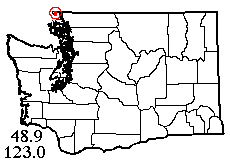 |
![]() 7 VI 2022: For years, we'd hoped to visit Point Roberts, a snippet of U.S. territory some 13 wet miles west of Blaine and separated from the rest of Washington by water — and Canada. To do the necessary 4 border crossings we needed the new "enhanced" IDs, not too hard to get, and to register with Canada's anti-Covid web site, featuring a classic Catch-22. However, the actual crossings were a breeze, and soon we were in the promised land under blue skies. Laurel hoped to find her research subject, Ozyptila praticola, in pine cones near the point's only (but surprisingly big) grocery store, and she did find … one juvenile. Ah well, it still proves it's there (fully expected, so close to where it's well-established in B.C.). Meanwhile, some parking-strip grass led me to a large (but recent) grass field where I swept 6 species, supplemented by 2 from Laurel's cones. Now, on to my primary goal, Baker Field Park!
7 VI 2022: For years, we'd hoped to visit Point Roberts, a snippet of U.S. territory some 13 wet miles west of Blaine and separated from the rest of Washington by water — and Canada. To do the necessary 4 border crossings we needed the new "enhanced" IDs, not too hard to get, and to register with Canada's anti-Covid web site, featuring a classic Catch-22. However, the actual crossings were a breeze, and soon we were in the promised land under blue skies. Laurel hoped to find her research subject, Ozyptila praticola, in pine cones near the point's only (but surprisingly big) grocery store, and she did find … one juvenile. Ah well, it still proves it's there (fully expected, so close to where it's well-established in B.C.). Meanwhile, some parking-strip grass led me to a large (but recent) grass field where I swept 6 species, supplemented by 2 from Laurel's cones. Now, on to my primary goal, Baker Field Park!
Having found the park's parking lot, we hiked to the end of one of the many trails before we found any leaf litter to speak of; not too much of it, but sifting got me 4 spider, 3 harvestman and 3 isopod species. Including (ta da) the native Ozyptila pacifica, still hanging on in a stronghold of its invasive congener. Laurel's moss sifting at this site added 6 more species; fern-beating, 4 more; while piles of junk and stones had nothing mature. Back down the trail, we stopped at a large, formerly grassy field, at least half consumed by blackberry, beside a water tower. My salal-beating added only one species, introduced Ero tuberculata. Douglas-fir foliage added 3, grass-sweeping 2, and broom-beating 1, while Laurel managed to find a couple of still-active wolf spiders. The star habitat was a chain-link fence around the water tower, from which Laurel chased down 9 species, 5 of them jumping spiders. With 3 more species from buildings by the trailhead, we now had 37.
Our last important site (as overcast rolled in) was Lily Point Park (SE corner of Pt. Roberts), where a goodly hike brought us to a gorgeous beach (where we were quite alone), once a cannery site. I managed to sweep 5 species from the vast beach meadow, 3 of which had eluded me at the other grassy sites. Laurel turned driftwood (finding 2 cool species) and vainly chased beach wolf spiders, while I climbed a bit back up the bluff trail to sift maple litter, still to be found in chinks of the devouring ivy that's taken over much of the littoral forest here. That was very worthwhile, adding 5 spider species and 2 more isopods. Under increasingly gloomy skies, Laurel wanted to reach a last pine cone site, so we fled Lily Point while a thankfully brief rain squall moistened us. At Lighthouse Point Marine Park (still dry), pine foliage added one more species and cones, none. So, homeward with a more than satisfactory 49 spider species where none were known before. The McChicken at the Tsawassen McDonald's was, bilingually speaking, a MacPoulet.
 |
![]() 15 VI 2022: The long-delayed trip with my friend Della finally took place! Not without a last-minute hitch, of course; I found out 2 days before that our intended destination in the North Fork Nooksack drainage was under a "wildlife closure." Fortunately, we had a backup plan, a remote bridge over the South Fork Canyon Creek, north of Green Mountain inside central Snohomish County's Mountain Loop. This trip involved driving over 8 miles of puddle-filled potholes on FS Road 41, but that wasn't a deal-breaker for Della; she says she learned to drive on such roads! And the mini-SUV she managed to get from ZipCar took the road like a pro. Driving behind us were Sandi Doughton and Erika Schultz from the Seattle Times, working on a feature article about spider collecting. We all made it, and it was quite a nice site; unfortunately, the shrubs and grass were somewhat wet, and a few unpredicted rain sprinkles didn't improve matters any.
15 VI 2022: The long-delayed trip with my friend Della finally took place! Not without a last-minute hitch, of course; I found out 2 days before that our intended destination in the North Fork Nooksack drainage was under a "wildlife closure." Fortunately, we had a backup plan, a remote bridge over the South Fork Canyon Creek, north of Green Mountain inside central Snohomish County's Mountain Loop. This trip involved driving over 8 miles of puddle-filled potholes on FS Road 41, but that wasn't a deal-breaker for Della; she says she learned to drive on such roads! And the mini-SUV she managed to get from ZipCar took the road like a pro. Driving behind us were Sandi Doughton and Erika Schultz from the Seattle Times, working on a feature article about spider collecting. We all made it, and it was quite a nice site; unfortunately, the shrubs and grass were somewhat wet, and a few unpredicted rain sprinkles didn't improve matters any.
There were alder stands at the site, but where was the leaf litter? I finally found some, pretty wet but I was able to demonstrate sifting to the Press, getting 4 species in about 3 bags of litter. To provide a bit of variety to the show, I beat conifer foliage next, one of the day's better habitats as it turned out, with 8 species. Now I wanted to sift moss, definitely the site's most abundant habitat; to avoid the rain sprinkles, I set up the sifter under tree canopy. This was still going strong at 4 pm (when Sandi and Erika left), eventually garnering 12 spider species; at this point, I had 19 in all. I tried tapping dead wood among the hemlocks on the steepish canyon sides, adding one more species although I should have had better boots to climb the steep, wet slopes without slipping. With an hour to go, I decided to sacrifice a net bag to the rain gods and sweep the wet grass on the gravel bar. This added two more species, one being a very nice Porrhomma convexum. In my final minutes before I'd agreed to head for home, I beat ferns on the banks above the gravel bar, adding 2 more. Total species for the day, 24, an acceptable sample considering it was just me collecting, in rather wet conditions, with distractions!
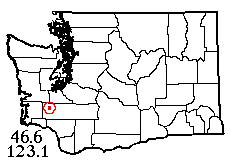 |
![]() 21 VI 2022: The sheaf of Lewis County trip plans I made this spring included one for a site on Bunker Creek, a major N-S connecting route between Highway 6 in the south and Lincoln Creek Road in the north. On a warm sunny day (for a change), Laurel and I parked at a mid-sized tract of wooded public land on the creek; the latter was muddy (agricultural erosion?) but the vegetation was fairly natural. Of course I sifted maple litter (which proved to be overrun with ants), getting a mature male Ozyptila pacifica and 3 other species, plus assorted non-spiders. Laurel had better luck tapping 100 Douglas-fir cones, with no less than 7 identifiable species. Sweeping a tall grass hayfield a short walk down the road got me 8 species, while tall grass understory by the creek added 5. Laurel did her usual treetrunk moss sift, adding 10 species including a tiny Trogloneta with a pink egg sac! My fern understory beat produced 14 species in all, including one linyphiid so-far unidentified. Our total for this rich site was 39 species.
21 VI 2022: The sheaf of Lewis County trip plans I made this spring included one for a site on Bunker Creek, a major N-S connecting route between Highway 6 in the south and Lincoln Creek Road in the north. On a warm sunny day (for a change), Laurel and I parked at a mid-sized tract of wooded public land on the creek; the latter was muddy (agricultural erosion?) but the vegetation was fairly natural. Of course I sifted maple litter (which proved to be overrun with ants), getting a mature male Ozyptila pacifica and 3 other species, plus assorted non-spiders. Laurel had better luck tapping 100 Douglas-fir cones, with no less than 7 identifiable species. Sweeping a tall grass hayfield a short walk down the road got me 8 species, while tall grass understory by the creek added 5. Laurel did her usual treetrunk moss sift, adding 10 species including a tiny Trogloneta with a pink egg sac! My fern understory beat produced 14 species in all, including one linyphiid so-far unidentified. Our total for this rich site was 39 species.
For additional habitats, I'd selected a nearby stretch of the Willapa Hills Trail, a recently established rail-trail (I still remember when it had trains on it). Laurel picked a spot where the trail crosses the Chehalis River beside a sand bar, while I went a quarter mile farther to a glade on the fringe of an adjacent clearcut, that had grass, broom, Douglas-fir foliage, and the cucumber-like Marah (manroot) vines. The vine-draped conifer foliage gave me 12 species, the broom added 3, and the grass one more (but brushing through the tall grass with deer sign led to my being collected by an Ixodes tick that I found next morning). Meanwhile, Laurel got 6 species on the bridge, 8 from sandbar vegetation (one a Walckenaeria unknown to me), some very nice Erigone capra making their webs in deer/elk hoofprints in the sand, and one solitary Pardosa xerampelina wolf spider still active. Our total for this day was 55 species, and a few prior records by another collector make it 58. And we made it home ahead of the freeway-construction lane closures.
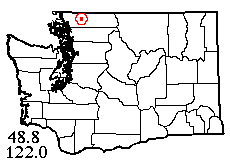 |
![]() 30 VI 2022: In recent years, our collecting in Whatcom County, western Washington's northernmost, had left only 3 gridspaces unsampled west of 120° longitude. Today's goal was one of these, the last one presently accessible. Jerry Austin and I went north from Sedro Woolley to Welcome (suburb of Deming), then up dead-end North Fork Road to a side logging road I was sure would be blocked — but wasn't! So we were able to drive all the way along the north slope of Slide Mountain to the unnamed creek where I intended to collect. The site was well-forested, moist and provided with fine habitats and spiders. I was just putting up our Discover Pass when a DNR truck came along! So, I started sifting alder-maple leaf litter and found it unusually rich for the end of June, with 10 spider species and other stuff, including an Ortholasma harvestman unexpectedly far from the coast. There was plenty of moss on alder trunks, and moss-sifting added 4. Later, Jerry and I both beat fern foliage here, and between us we added 8 more species (including Laurel-pleasing Ozyptila pacifica). With a male Araniella that descended onto the car, we now had 23 species from this first site.
30 VI 2022: In recent years, our collecting in Whatcom County, western Washington's northernmost, had left only 3 gridspaces unsampled west of 120° longitude. Today's goal was one of these, the last one presently accessible. Jerry Austin and I went north from Sedro Woolley to Welcome (suburb of Deming), then up dead-end North Fork Road to a side logging road I was sure would be blocked — but wasn't! So we were able to drive all the way along the north slope of Slide Mountain to the unnamed creek where I intended to collect. The site was well-forested, moist and provided with fine habitats and spiders. I was just putting up our Discover Pass when a DNR truck came along! So, I started sifting alder-maple leaf litter and found it unusually rich for the end of June, with 10 spider species and other stuff, including an Ortholasma harvestman unexpectedly far from the coast. There was plenty of moss on alder trunks, and moss-sifting added 4. Later, Jerry and I both beat fern foliage here, and between us we added 8 more species (including Laurel-pleasing Ozyptila pacifica). With a male Araniella that descended onto the car, we now had 23 species from this first site.
Now, I hiked farther up the road (past several curves) until I was below a younger clearcut that had what I thought would be accessible Douglas-fir foliage. But that clearcut wasn't designed for pedestrians! Floored with variably rotted slash and grown with cutleaf and vine blackberry, it made old-movie jungles look like a Sunday stroll. I managed to struggle within reach of about 4 trees, but the spiders beaten from the foliage didn't justify the effort, adding 5 species. While there, I got one mature wolf spider on a log and a couple of nice Neriene radiata in their webs — and aggressively biting ants all over my backpack. Probably I could have found a better, much easier conifer sample had I but hiked farther up the road; oh well. Now, all this time Jerry had been sweeping roadside verge, starting with buttercups at our first riparian site and continuing to grass verge below my clearcut. This added 6 species to our other material, and a separate verge-sweep higher up added 2 more, uncommon Xysticus luctuosus and an unidentified Linyphantes. Being a bit worried about the car's engine temperature, we left at 7 with a solid sample of 37 species. A pint of oil seemingly cured whatever was making the car run hot. And the natives were friendly at the aptly-named Welcome Store.
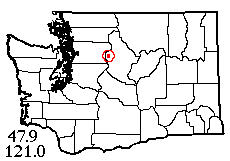 |
![]() 9 VII 2022: With the extremely cool, wet spring we'd had, we figured early July wasn't too late for an east-slope Cascades site close to the crest. That proved correct. But an unexpected drawback was having to pass through the "Sultan Shindig" event, entailing a loss of over 30 minutes field time sitting in traffic! Preceding us, but similarly delayed, were reporter Sandi Doughton (still working on that story about me) and her friend David. After a very long drive, we all came together at the very end of the Little Wenatchee forest service road, a former campground called Little Wenatchee Ford, now a trailhead that soon branches into three major trails (Little Wenatchee, Cady Pass and Poe Mountain).
9 VII 2022: With the extremely cool, wet spring we'd had, we figured early July wasn't too late for an east-slope Cascades site close to the crest. That proved correct. But an unexpected drawback was having to pass through the "Sultan Shindig" event, entailing a loss of over 30 minutes field time sitting in traffic! Preceding us, but similarly delayed, were reporter Sandi Doughton (still working on that story about me) and her friend David. After a very long drive, we all came together at the very end of the Little Wenatchee forest service road, a former campground called Little Wenatchee Ford, now a trailhead that soon branches into three major trails (Little Wenatchee, Cady Pass and Poe Mountain).
We began work at the trailhead, where I beat varied conifers and got a nice diverse 11-species spider sample. Laurel, under the watchful eye of the Press, collected from the outhouse building, finding some of the same species but also Steatoda hespera with eggs, an unidentified Dictyna, and Phildromus spectabilis with prey. I then moved on to a tiny meadow at the first trail junction, sweeping it for 7 species, while Laurel (with Sandi) hiked up to a larger, higher meadow farther along the Little Wenatchee Trail, there to sweep the same number of species (but with some of them different) and return with a rosy report of the habitats to entice me upward. She also collected from aerial webs and loose true-fir bark in the forest, but that added nothing mature to the trailhead sample.
We re-united at the Cady Pass Trail footbridge over the river. There was lots of alder here, but all growing on near-vertical ravine sides, so I could retrieve little litter, which I sifted with little result. Laurel tapped 100 Douglas-fir cones at the bridge but got only juveniles of Cybaeopsis and Cryphoeca. Sandi helped her chase wolf spiders. I sifted moss by a creeklet above the bridge, adding one species. Then I hiked up to Laurel's wonderful meadow, where I sifted vine maple litter which added at least 2 nice microspider species. Sandi and David having departed, I pointed Laurel to a promising area of rocks-on-soil near the trailhead (which produced 3 good species) while I tapped the abundant dead wood near the big meadow, getting 8 species, half of them adding to the list. About to leave, we found one last spider on the car (a male Cyclosa). Our total for the 7910 gridspace, at least 32 species.
 |
![]() 21 VII 2022: For a few years I've had my eye on a road that goes north from the semi-inaccessible North Fork Skykomish River at a place called Galena (where some people still live, at least in summer), up Silver Creek toward the mysterious Mineral City. It's Road 6340 on Forest Service maps. Today seemed a good time to try it. The road soon became more of a jeep trail, so we parked near the bottom of the hill and hiked, up a pleasant, gentle gradient. At a point where the Forest Service still considers it a road, it becomes a hiking trail with a (blank) trailhead sign. This seemed a good point to stop and collect, since moss, litter, understory and a rockslide were available.
21 VII 2022: For a few years I've had my eye on a road that goes north from the semi-inaccessible North Fork Skykomish River at a place called Galena (where some people still live, at least in summer), up Silver Creek toward the mysterious Mineral City. It's Road 6340 on Forest Service maps. Today seemed a good time to try it. The road soon became more of a jeep trail, so we parked near the bottom of the hill and hiked, up a pleasant, gentle gradient. At a point where the Forest Service still considers it a road, it becomes a hiking trail with a (blank) trailhead sign. This seemed a good point to stop and collect, since moss, litter, understory and a rockslide were available.
Beating shaded western hemlock foliage along the trail produced only 5 species. There was some nice alder-conifer litter in the chinks between rocks in one of the many gulches, and this added 6 more. Laurel sifted a fair number of spiders from moss, but only 3 species added to the sample. She turned rocks in a hikers' fireplace, getting only juveniles, but some charred firewood had Bathyphantes keenii under it. While I was still sifting, Laurel headed north a "short distance" up the trail. I beat fern understory, adding only 2 or 3 more, and at this point we had only 17 from the original site.
Laurel had been gone a long time and I was getting concerned, but fortunately she reappeared at the far side of the big rockslide just as I was about to start across in search of her. She'd gone nearly a mile farther, and taken an extremely helpful beat sample from sun-exposed conifers along the rockslides, adding 7 species; plus 3 more along a rocky side stream. The best record was both sexes of Dipoena nigra. We didn't manage to add any more on the way back to the car, but we had an adequate 27 species, and a day spent in very pleasant solitude with scenery, an old mine portal, and ripe huckleberries.
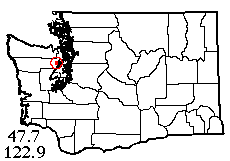 |
![]() 1 VIII 2022: A heat wave with highs into the 90s had kept us home, so on Monday we welcomed a 74-degree prediction for Buck Mountain on the Olympic Peninsula. This time the ferry wasn't crowded at all. Just south of Quilcene, we stopped at Falls View Campground (permanently closed to camping — even the picnic tables were removed) to get a riparian sample on the Big Quilcene River. Starting with 4 species from outhouses and one from upland shrubs, we descended a trail into the river's deep canyon to find a still-moist riparian world; however, a bag of maple litter added only one mature spider species. Laurel did better with moss on maple trunks, adding 5 including quite a nice male Trogloneta; there was more moss to be had in the fallen "clods," lumps of moss from high maple branches that fall intact to the ground, adding only 3 more but including an uncommon Bathyphantes. Understory brought us up to 19 for the site.
1 VIII 2022: A heat wave with highs into the 90s had kept us home, so on Monday we welcomed a 74-degree prediction for Buck Mountain on the Olympic Peninsula. This time the ferry wasn't crowded at all. Just south of Quilcene, we stopped at Falls View Campground (permanently closed to camping — even the picnic tables were removed) to get a riparian sample on the Big Quilcene River. Starting with 4 species from outhouses and one from upland shrubs, we descended a trail into the river's deep canyon to find a still-moist riparian world; however, a bag of maple litter added only one mature spider species. Laurel did better with moss on maple trunks, adding 5 including quite a nice male Trogloneta; there was more moss to be had in the fallen "clods," lumps of moss from high maple branches that fall intact to the ground, adding only 3 more but including an uncommon Bathyphantes. Understory brought us up to 19 for the site.
My main goal, the summit ridge of Buck Mountain, was reached by a spur road from the main forest road that crosses one side of the mountain. At first, the road wasn't bad going at all, but with under a mile to go, we hit a patch of small round gravel that had our tires spinning! Unable to proceed, Laurel laboriously turned around and talked me into collecting where we sat, some 400 feet lower than planned. True, the day was just a bit warmer than predicted!
Spiders at our young-forest roadside were a bit sparse, but diverse. Beating conifers added 5 species, with one extra from a Ribes bush. I added 3 more sweeping roadside verge and one beating salal. Laurel added a Xysticus from dry moss on a Douglas-fir trunk, a Salticus scenicus (of all things) under a rock, a few in aerial webs, and one female Pardosa under dead wood. Hoping to add more species, we stopped on the way down at a roadside field (where we got Neriene litigiosa) and the road-crossing of Mile-and-a-Half Creek which added Tetragnatha versicolor; total for the 2+-site sample, 34 species. The return trip went so speedily we got home before sunset.
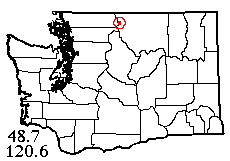 |
![]() 7-9 VIII 2022: All my adult life, I've been hearing about the famous Slate Peak from butterfly people. Jerry had tried collecting spiders there twice and fallen just short of 20 species. This year, my trip there with the Austins finally took place. The weather prediction looked ideal, and we hoped to complete the main sample and get one or two others. The best-laid plans… The journey from Seattle started late and took forever; despite our meeting several Sunday-night departers on the way in, tiny Harts Pass camp-ground was still full, and I suggested Deer Park Campground on the topo map, not far down an "unmaintained" (but no worse) road. Turns out it's no longer an official campground, but still there, blessedly empty, and all in all quite a pleasant place. We arrived just in time to set up camp by dusk.
7-9 VIII 2022: All my adult life, I've been hearing about the famous Slate Peak from butterfly people. Jerry had tried collecting spiders there twice and fallen just short of 20 species. This year, my trip there with the Austins finally took place. The weather prediction looked ideal, and we hoped to complete the main sample and get one or two others. The best-laid plans… The journey from Seattle started late and took forever; despite our meeting several Sunday-night departers on the way in, tiny Harts Pass camp-ground was still full, and I suggested Deer Park Campground on the topo map, not far down an "unmaintained" (but no worse) road. Turns out it's no longer an official campground, but still there, blessedly empty, and all in all quite a pleasant place. We arrived just in time to set up camp by dusk.
I hadn't camped in 9 years, but I'd successfully had my tent repaired, was fairly comfortable in my bag — but couldn't sleep! Camping skills more than a trifle rusty, I fear. I finally got a couple hours of REM toward dawn. Then the cool night transformed into a much hotter-than-predicted day. Fred dropped Jerry off at a trailhead where he hoped to hike into the next area north of Slate Peak, while I did some sampling around camp (5 species from conifers and 3 from meadows), then planned to hike down the road into the next gridspace west. Well, the road went down, down more steeply than I'd bargained on, I was hot, super-tired and had a full pack, and soon realized that I really couldn't do this today. The GPS told me I was less than halfway to my goal. So I got three more species from the roadside where I was, then headed back to camp, where I tried to nap, and did a bunch more meadow sweeping to little effect. But at least I'd brought the main sample up to 25 species! A couple of good ones too. Then at 5, I joined Fred and we drove up to Slate Pass to rendezvous with Jerry.
Jerry made it back from his hike in good time, and puzzled for hours trying to figure out where he'd been! The upshot was that he hadn't made it out of the Slate Peak gridspace either, but on Gold Ridge had added some good species including Araneus nordmanni and Pardosa rainieriana. So we successfully boosted the main sample to 30 species, but got none from elsewhere. Most of Tuesday was occupied getting home, with the only highlight a burger and shake at Cascade Burgers in Concrete. The flies and mosquitos in the Harts Pass area weren't as bad as hiker reports warned, but they were certainly in there pitching. Well, now I've been there!
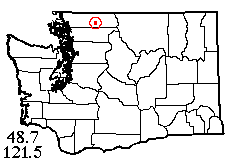 |
![]() 13 VIII 2022: Four days after the Slate Peak marathon, I was ready for a day trip, and Laurel was up for it. We picked the Baker River Trail, at the head of Baker Lake and well into the national forest though not so high in elevation. We reached the trailhead easily, and strolled up the practically level trail to where the Baker Lake Trail joins it via a well-known suspension bridge. On the far side of the bridge was a USGS stream monitor station, making a fine sifting platform in lush surroundings. The river itself had no shortage of beautiful water, appearing clear or blue-green.
13 VIII 2022: Four days after the Slate Peak marathon, I was ready for a day trip, and Laurel was up for it. We picked the Baker River Trail, at the head of Baker Lake and well into the national forest though not so high in elevation. We reached the trailhead easily, and strolled up the practically level trail to where the Baker Lake Trail joins it via a well-known suspension bridge. On the far side of the bridge was a USGS stream monitor station, making a fine sifting platform in lush surroundings. The river itself had no shortage of beautiful water, appearing clear or blue-green.
There wasn't very much litter available to sift, but it made a start of 3 species. Three others were on shaded young hemlocks. Some good-sized fallen bark slabs gave me 5 unusually interesting additions, including a Ceratinella I don't recognize. Laurel added 4 from the bridge railings, sifted 9 from moss even though the latter was pretty dry, and got two different Cybaeus species under shaded rocks near the river. I devoted some time to understory-beating, for 10 species. It being Saturday, there were plenty of others on the trail, and we got our full share of questions. This time the huckleberries were red, my favorites!
I hadn't had any good conifer beating or grass-sweeping, and hoped to find these habitats back near the trailhead, adjacent to a very extensive "gravel bar plain" with occasional thickets. Although most of the campgrounds on the lake weren't quite full, campers were everywhere around the trailhead and along the road! But I found a little grass to sweep, though it only added one species. There were young Douglas-firs here and there, but the pitiless sun during recent heat waves had singed their foliage, and the spiders were sparse indeed, still adding two more. Laurel added two good ones from the trailhead outhouse, and we headed home with 32 species, at just the right time to capture a lovely sunset.
 |
![]() 8 IX 2022: The latest in a succession of heat waves was ending, and a siege of fire weather with smoky air soon to arrive, so I thought it'd be wise to slip a field trip into the chink. I let Laurel choose among several foot-hill and mountain sites; no big surprise that the pine cone queen chose Pinus Lake! Located on an obscure mid-elevation plateau overlooking the North Fork Nooksack River a mile or so above Nooksack Falls (which we didn't see), it was small but seemed inviting. The road was no worse than the usual forest road until we had around a half mile to go, then the wheels spun and we had to park and walk, no great hardship on a nice day. Passing a state radio facility at the plateau's summit, I continued down the road-now-become-trail looking for a path to the lake. None! Laurel finally spotted a 3-inch bit of flagging tape that marked the spot to begin cross country trekking. It wasn't far to the lake, but seemed like it in the obstacle course of logs and limbs. Then we were there, a lovely little spot I must admit, with a wholly unexpected Sphagnum bog, but of course no pines!
8 IX 2022: The latest in a succession of heat waves was ending, and a siege of fire weather with smoky air soon to arrive, so I thought it'd be wise to slip a field trip into the chink. I let Laurel choose among several foot-hill and mountain sites; no big surprise that the pine cone queen chose Pinus Lake! Located on an obscure mid-elevation plateau overlooking the North Fork Nooksack River a mile or so above Nooksack Falls (which we didn't see), it was small but seemed inviting. The road was no worse than the usual forest road until we had around a half mile to go, then the wheels spun and we had to park and walk, no great hardship on a nice day. Passing a state radio facility at the plateau's summit, I continued down the road-now-become-trail looking for a path to the lake. None! Laurel finally spotted a 3-inch bit of flagging tape that marked the spot to begin cross country trekking. It wasn't far to the lake, but seemed like it in the obstacle course of logs and limbs. Then we were there, a lovely little spot I must admit, with a wholly unexpected Sphagnum bog, but of course no pines!
Laurel wandered off beating foliage while I looked for something to sift. I thought there were a few alders around, but they were really alder-colored hemlocks! Besides a few pockets of shrub litter, there was mainly the rather shallow layer of Sphagnum, normally a fine spider source. But this time there were no spiders until the bottom of the net, and only one of those mature (an interesting Symmigma minimum). Luckily, there was some dead wood here and there in the mature forest, and that gave me 5 more species. I got only 3-4 from salal understory, but Laurel did better with huckleberry (good eating, too) and shade conifers. Still, after all that trouble we came away from Pinus Lake with only 13 species! Back up at the radio site, conifers in the sun brought this up to 17, and there were butterflies and grasshoppers to watch and a cliff to not fall off.
Now, success or failure depended on how we did down by the river below our plateau. I began by sweeping grassy verge across the highway; lush-enough looking, but added only one species. The low-hanging branches of bigger conifers got me nothing we hadn't taken up above. But Laurel added 3 nice species from the highway guardrails, and she let me sift the moss this time (gathered by both of us, and very dusty, but adding 3 worthwhile species). Laurel found a lovely Zygiella dispar on a traffic sign, and I tried the understory of the riparian woodland, adding two more and another harvestman. In the end, hard work paid off with an adequate 28 spider species. On the way home, 3 spiders from Laurel's home condo crawled across our windshield!
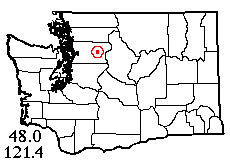 |
![]() 30 IX 2022: The first fall trip was planned to be another ZipCar expedition with Della Scott driving. I waited until we'd had the first rain, then a day and a half later we headed north. We'd originally planned a longer trip to the Nooksack drainage, but because of a slight delay in departure we switched destinations to Palmer Creek, up the south arm of the Mountain Loop from Silverton. Though only a half-mile off the highway, the site was very peaceful and the temperature pleasant. I was hoping for a bridge where Road 4065 crosses the creek, but nope, only a big culvert. Leaf litter was far from abundant, but it existed in pockets here and there, and glory be, it was damp!
30 IX 2022: The first fall trip was planned to be another ZipCar expedition with Della Scott driving. I waited until we'd had the first rain, then a day and a half later we headed north. We'd originally planned a longer trip to the Nooksack drainage, but because of a slight delay in departure we switched destinations to Palmer Creek, up the south arm of the Mountain Loop from Silverton. Though only a half-mile off the highway, the site was very peaceful and the temperature pleasant. I was hoping for a bridge where Road 4065 crosses the creek, but nope, only a big culvert. Leaf litter was far from abundant, but it existed in pockets here and there, and glory be, it was damp!
Sifting two bags of litter (mainly alder) got me 7 species, not bad for so early in the season. Moss on the alders was still pretty dry, but nonetheless added 5 species. The forest contained a good deal of dead wood in chunks suitable for spider-tapping, and I was able to get 5 spider species from this habitat, but alas, only one of those added to the sift samples. Sweeping roadside verge added 4 more species for a total of 17. I could have continued sampling other kinds of vegetation at this site, but I had a hunch that searching for a second site with better conifer foliage access would get me more, so we loaded up and trucked on up the mountain, the gravel road not being too bad, scanning roadside vegetation.
Within a mile, we had a site with sufficient roadside western hemlock foliage, plus a parking spot, so we stopped and I began beating the trees! After beating the hemlocks I could reach within a hundred meters of the car, I had a sample of 11 arboreal spider species, only three duplicating the creekside sample. Sweeping roadside grass added two more. Our bottom line before heading for home(s) was a solid 27 species.
 |
![]() 6 X 2022: Last week's success encouraged me to plan another trip with Laurel, even though no additional rain had fallen. What I hadn't figured on was my body mysteriously damaging my own right leg while I slept the previous morning! We chose a trip plan in an area labeled "Michigan Hill" on topo maps, even though there's no summit there, just a stretch of rolling countryside. At the extreme SW corner of Thurston County, the area is mostly working forest. The planned site was on Port Blakely Tree Farms land, usually no problem for access. However, today our chosen road was being used for an active logging operation, therefore closed. About a mile north, we'd passed a different Port Blakely tract that wasn't closed, so we decided to try that. Turns out, this led into a clearcut so new (about 1 year old), it's not on most aerial photos. But it was already well-developed into grassland, with (juvenile) wolf spiders running about, and other species to be swept.
6 X 2022: Last week's success encouraged me to plan another trip with Laurel, even though no additional rain had fallen. What I hadn't figured on was my body mysteriously damaging my own right leg while I slept the previous morning! We chose a trip plan in an area labeled "Michigan Hill" on topo maps, even though there's no summit there, just a stretch of rolling countryside. At the extreme SW corner of Thurston County, the area is mostly working forest. The planned site was on Port Blakely Tree Farms land, usually no problem for access. However, today our chosen road was being used for an active logging operation, therefore closed. About a mile north, we'd passed a different Port Blakely tract that wasn't closed, so we decided to try that. Turns out, this led into a clearcut so new (about 1 year old), it's not on most aerial photos. But it was already well-developed into grassland, with (juvenile) wolf spiders running about, and other species to be swept.
I painfully hobbled around the new clearcut, sweeping about 9 species; meanwhile, Laurel beat Douglas-fir foliage at the edge of an already-planted clearcut across the road, and did some sweeping there as well. The catch included such nice records as Neoscona arabesca (a native orbweaver), Ceraticelus fissiceps and Spirembolus mundus, with Crustulina sticta under bark on the ground; 15 species already. Now, the new road through the new clearcut connected with an old road heading into a young forest, who knew how far, and we both moved onward (me going slowly, with pauses), looking for a stream. Arrived at the brink of a ravine (and the end of the road), it was too steep for me to continue in my disabled condition, but Laurel scrambled down to get some moss and litter while I beat reasonably productive fern understory. Both the moss and litter produced Laurel's favorite, Ozyptila pacifica, and on the way in and out she added spiders from Douglas-fir cones and one large orbweaver. As we slowly returned to the car, we had 30 spider species plus a lovely Ethopolys centipede.
The time was only about 4:30, so we decided to try an alternate site up Drewry road a short distance to the north. Here, I sifted some litter, beat some conifer foliage, and then ran out of steam, having added two more species. Laurel, supplied with undamaged legs, sifted moss from two different tree groves and brought our final total up to 39. Nice going for one-and-a-half collectors!
 |
![]() 20 X 2022: The incredibly-dry October marched on, while my leg trouble (still undiagnosed) slowly improved. On the last day of a "partly sunny" forecast prior to a long rainy spell, I felt up to an attempt in moister habitats along the coast highway. Our original goal was a swampy creek north of Elma, but on our way south the clouds began to drizzle! Arrived in our area, sky-drip intermittently continued, so we decided to begin with a fishing-access site on Decker Creek where I hoped there'd be some forest-canopy protection. Arrived there, we found most of the understory sprinkled, but plenty of litter and moss to sift, so we began on that.
20 X 2022: The incredibly-dry October marched on, while my leg trouble (still undiagnosed) slowly improved. On the last day of a "partly sunny" forecast prior to a long rainy spell, I felt up to an attempt in moister habitats along the coast highway. Our original goal was a swampy creek north of Elma, but on our way south the clouds began to drizzle! Arrived in our area, sky-drip intermittently continued, so we decided to begin with a fishing-access site on Decker Creek where I hoped there'd be some forest-canopy protection. Arrived there, we found most of the understory sprinkled, but plenty of litter and moss to sift, so we began on that.
I sifted enough diversity from my first bag of litter to encourage me, and kept going through about five bags. Very worthwhile, with a 19-species sift sample my reward. Laurel got 18 species from moss, adding 14 to my 19. She got 4 more on and under the bridge; grass under the bridge added 2; a fairly dry Douglas-fir tree added 3; Laurel turned over some paper-bag trash under the bridge and found no less than 3 species of Bathyphantes; and a single spider descended onto her via a dragline: the uncommon Rhomphaea fictilium! At this seemingly second-string site we had 44 species by mid-afternoon.
We were so low on fuel that we decided to make Satsop Cemetery, on our direct route back to a gas station, our remaining site for the day. The open cemetery was pretty wet, but Laurel found some nice species on a small service building, while I wandered about with my net looking for places where the rain hadn't penetrated the tree canopy. Eventually, after 4 pm, the sun finally broke through and I found what I was seeking in the wooded fringe of a pasture across the road. Here, fern understory and the lower branches of sheltering Douglas-firs got me 7 nice additions to the list. The late sun began drying the tombstones, so Laurel was able to scan them for spiders after all, but the best two were under those built-in flower urns, one of them being the same undescribed linyphiid we'd taken in similar habitats in other cemeteries. The bottom line for this fine fall trip was 54 species, and we dined well at Smitty's In-and-Out in Elma. And the air quality was fine, though Seattle's air that day was smokily "unhealthy."
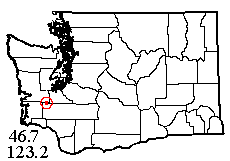 |
![]() 29 X 2022: A Saturday interruption to the fall rains was predicted, and for a wonder Jerry Austin was able to drive on a field trip. The best forecast was for a site on Lepisto Road, west of our Oct. 6 site but at the edge of a good-sized chunk of public land. I hadn't thought to check on it, but it seems it was hunting season: hunters were everywhere. We parked at a locked gate, where all but a couple of the hunters who arrived drove in, then turned right around and drove out! So for most of the day there were few bangs. Much of the vegetation was still at least somewhat wet, but about half of the abundant, lush conifer foliage had few enough drips on it that our nets only became damp, not soaked. Between roadside, forest interior and a grassy clearcut, we managed to get 22 conifer species between us including some very nice records: Metellina mimetoides and yet another Rhomphaea fictilium among them.
29 X 2022: A Saturday interruption to the fall rains was predicted, and for a wonder Jerry Austin was able to drive on a field trip. The best forecast was for a site on Lepisto Road, west of our Oct. 6 site but at the edge of a good-sized chunk of public land. I hadn't thought to check on it, but it seems it was hunting season: hunters were everywhere. We parked at a locked gate, where all but a couple of the hunters who arrived drove in, then turned right around and drove out! So for most of the day there were few bangs. Much of the vegetation was still at least somewhat wet, but about half of the abundant, lush conifer foliage had few enough drips on it that our nets only became damp, not soaked. Between roadside, forest interior and a grassy clearcut, we managed to get 22 conifer species between us including some very nice records: Metellina mimetoides and yet another Rhomphaea fictilium among them.
Beating Scots broom got me a few of its characteristic spiders, and a short stretch of barely-wet fern understory (along a former side road overgrown into a trail) netted no less than 4 additions. And now it was finally warm enough to sift, so I began sifting moss. The extremely varied patchwork of habitats included plenty of young maple trees and a row of bigger ones along the road, furnishing plenty of moss that oddly enough lacked such "usual suspects" as Ethobuella, but still added 13 species to our total, including a Laurel-pleasing Ozyptila pacifica. The leaf litter, which I'd saved for last, was none too spider-rich, and halfway through, the spiders dried up completely. Perhaps it was getting too cold to sift, but it certainly didn't feel like it. Oh well, it still added 4 more including both sexes of Cicurina tersa.
There was little daylight left at this point, and with sifting over, I located Jerry and we headed back to the car. I loaded my stuff in and assumed Jerry had done the same. Driving out, mostly through small farms, we saw mist or fog rising from the ground in most of the fields and pastures. At one point we paused so I could get a sunset shot, then continued homeward. With a short day, neither as warm nor as dry as hoped, we still got 42-44 species. But on arriving home, Jerry discovered he didn't have his trusty net! He must have left it on the ground at that parking spot in front of the gate…
The field year still proceeds in fits and starts, but we are managing to get out!
This page last updated 21 March, 2025